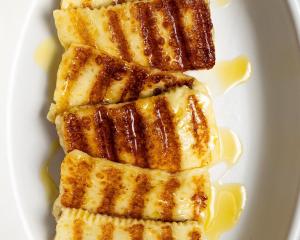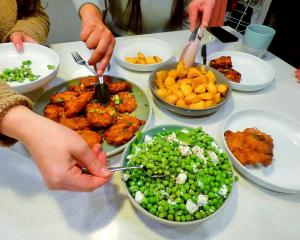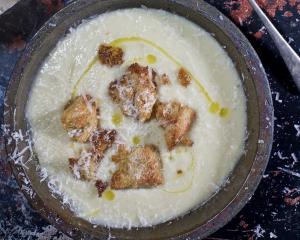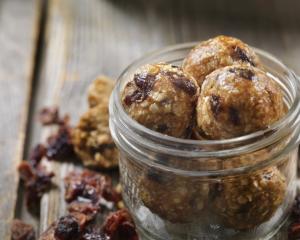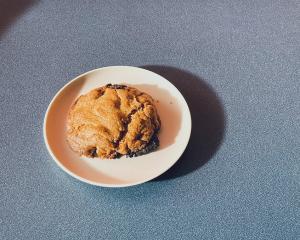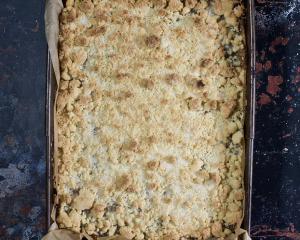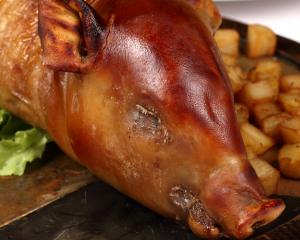
It was an idea that formed with each visit of a producer to the restaurant he worked in, Noble Rot.
"Each morning twinkly-eyed and smiling growers would turn up with their boxes and crates of glistening produce. It set a thought in motion: ‘They’re outside all day, tanned and healthy, whereas I’m here, skin a shade somewhere between yellow and grey, living off coffee and spending my day stressed to the core in a windowless kitchen’."
He moved in winter when everything was frozen solid, but decided to buy some pigs, thinking they would be hardy enough.
"They seemed like a bold first step that would keep me rooted to this plan long enough I wouldn’t bail without giving it a proper go."
It worked - four pigs turned into chickens, growing veges, his first goats and a small flock of sheep (rare primitive breeds). Soon it all outgrew their plot, so he sold up and bought a small farm — where no chemicals or artificial fertilisers had been used in over 30 years - in Dorset, in the west of England, and moved the animals, three beehives, animal shelters and a tractor across the country.
"Here we aim to provide a sanctuary for nature, an oasis in the desert while also growing food."
They have wildflower mixes growing in a meadow restoration project, and are endeavouring to create a dynamic habitat called woodland pasture to provide a home for many species as well as grazing for animals.
"It might look dreamy from afar, and a lot of time it is. On a good day this is an extraordinary way of life, waking with the sun, your day dictated by the seasons, out there in the elements at one with nature. Even on a bad day, there’s a real truth to it, a beauty in the hard moments. Nature is tough and unforgiving."
It has taken eight years for Roberts to get to this point, learning on the fly and through a series of setbacks and hard-won lessons.
"I’ve had some brilliant advice along the way and met some fantastic mentors, but really the most important things I’ve learnt have been through some pretty brutal mistakes."

The main source of income for the farm are the lambs he produces, which get sold to friends, family and local butchers as hogget. Roberts still struggles with sending animals to the abattoir.
"It feels the ultimate betrayal and I often teeter on the edge. But it is also a great privilege to know where your food comes from and the true price of it: the hours of care and careful husbandry, the relationship with the land from whence they came and the moral cost of death and what it means."
His initial plan was to see if he could get close to self-sufficiency, but now he sees it as a way to learn and to see where it takes him — possibly to building his own place to host people and share his world and hard-won knowledge.
"Throughout my journey, cooking has been at the core of it all: it is how I interact with the world, my way of sharing and giving."
The kitchen is the heart of his home and the recipes in his book The Farm Table are, he says, "ideas to inspire rather than rules to follow organised by the seasons, as that’s how I believe we should be eating".
"While I’ve got a little restaurant experience under my belt, deep down I’m just a home cook who loves his food."
So his recipes have been created during his first three years on the farm to be simple, and let the flavours shine.
"If you like something, I implore you to play with it and adapt it to the produce available around you."
The Book
The Farm Table, Julius Roberts, Imprint: Ebury Press RRP: $65
 Epic tarragon roast chicken
Epic tarragon roast chicken

There are recipes in this book that I love because they are interesting, there are those that I love for their simplicity and there are those that I find myself making again and again.
This is the latter, a great roast chicken, the heart of home cooking and one of life’s great pleasures. I relish the ritual, my family’s fight over the wings, the secret chef’s treats of the oysters, the leftover sandwiches and bubbling stocks.
There is no meal that makes me feel more at home. In my mind, there are three keys to a good roast chicken ... juicy meat, brown salty skin and most importantly a ton of sauce.
And it’s the sauce of this chicken that really sets it apart: handfuls of tarragon, lashings of cream and a proper dollop of mustard, which when combined with the cooking juices, garlic and wine creates a truly epic mouthful.
Serves 5
Ingredients
1 organic chicken
3 Tbsp olive oil
1 whole head of garlic
250ml quality double cream
20g bunch of fresh tarragon, stalks removed, roughly chopped
1 large heaped Tbsp Dijon mustard
a glass of dry white wine
Method
Preheat your oven to 220°C fan and start by spatchcocking the chicken. To do this, turn it over and cut along one side of the spine from the tail to the neck. Then turn it over, open out the two sides and press down hard to flatten it. Your butcher will gladly do this for you.
Lay the chicken in a large, high-sided roasting tray, season generously with salt on both sides and leave for an hour at room temperature so it loses the chill of the fridge.
When ready, generously drizzle the skin with olive oil and work it into all the nooks and crannies. Smash the head of garlic and hide the cloves underneath the chicken, then roast in the oven for 20–30 minutes, until the skin begins to turn golden brown.
Meanwhile, mix the cream, tarragon and mustard in a bowl and season well with salt and pepper.
After 20 to 30 minutes, turn the oven down to 140°C fan, take out the chicken and pour a generous glass of white wine into the tray. Then pour the tarragon cream all over the chicken and place back in the oven for 30 to 40 minutes until it’s ready.
To judge when it’s cooked, I check the deepest part of the thigh with a temperature probe, looking for 65 to 70°C. If you don’t have one, prod this point with a skewer and ensure the juices run clear. At this point, remove from the oven and leave to rest for 15 minutes, covered loosely with a bit of foil.
Carve straight into the tray and serve as you like, with lots of the sauce, garlic and a zingy green salad.
 Steamed apricot sponge
Steamed apricot sponge

A steamed sponge is a glorious thing: effortless to make, juicy and light as air. These mini sponges are cooked with tart stewed apricots at the bottom of the moulds, which ooze into the sponge when flipped.
Apricots are my favourite fruit for cooking, their tartness just heaven against the sweetness of the sponge. But the apricot season is short and this is a dish worth making throughout the year, so substitute in any stewed fruit - just make sure it’s jammy and not too wet. In winter, marmalade makes a great replacement.
Serves 4
Ingredients
For the stewed apricots
40g butter
6 apricots, halved and pitted
3 Tbsp caster sugar
a splash of apple brandy, Madeira or any sweet booze
For the sponge
90g unsalted butter, at room temperature, plus extra for greasing
90g caster sugar
zest and juice of 1 unwaxed lemon
2 eggs, lightly beaten
115g self-raising flour
½ tsp baking powder
2 Tbsp whole milk
For serving
Home-made custard, ice cream, creme fraiche or double cream
Method
Preheat your oven to 180°C fan and generously grease four dariole moulds with butter. Start with the apricots.
Put the butter into a pan that will fit the apricots snugly in one layer, then turn on the heat and when the butter begins to foam, add the apricots cut side down. Sprinkle over the sugar and cook for 4 minutes, until they begin to soften, then flip the apricots and pour in the brandy. Cook for a further 3 minutes, then turn the heat off and let them sit in their own juices. You want them cooked enough that they’re softened and have created a lovely syrup but aren’t falling apart.
For the sponge, use a stand mixer or electric whisk to cream the butter, sugar and lemon zest for about 5 minutes, until pale and fluffy. With the mixer/whisk still running, slowly pour in the beaten eggs. Then sift in the flour and baking powder, fold together and stir through the milk and lemon juice.
Place three apricot halves and a generous spoonful of their syrup in the bottom of each mould. Top with the sponge mix but don’t fill it right to the top, as they rise quite a long way up. Cover each mould with a circle of baking parchment. These can sit in the fridge until you want to cook them. Place the moulds in a high-sided baking tray and fill the tray with boiling water to come halfway up the moulds.
Cover the tray tightly with foil and bake for 35–40 minutes.
To test for done-ness, insert a skewer into the centre of the sponge; it should come out clean. Remove from the oven, take off the baking parchment and run your knife around each sponge. Flip them into bowls and serve with home-made custard, ice cream, creme fraiche or double cream.
 Courgette pasta with mascarpone, basil and lemon
Courgette pasta with mascarpone, basil and lemon

Home-grown courgettes cooking in a puddle of good olive oil with garlic, lemon and chilli is a combination that sings of summer to me.
I make this almost every day from June to September, to be stirred through risotto, served next to a piece of fish, on toast with burrata, or with my eggs in the morning.
But my personal favourite is tossed through pasta with mascarpone, fresh basil and lemon. It’s sheer joy, zingy and fresh with a gentle hum of chilli.
Pictured here with home-made cavatelli, a much-loved pasta that’s incredibly easy to make, with a pleasing texture that goes so well with this dish.
Serves 4
Ingredients
1kg courgettes (ideally a few different colours, shapes and sizes)
5 tbsp olive oil
4 large cloves of garlic,
finely sliced
a generous pinch of chilli flakes
400g pasta (I love using home-made cavatelli but penne, tortiglioni and linguine are also great)
1 large unwaxed lemon
3 tbsp mascarpone
a large bunch of fresh basil, leaves picked (mint also works very well)
a knob of butter, about 30g

Method
Start by bringing a large pan of well-seasoned water to the boil for the pasta.
Slice the courgettes into rounds about as thick as your little finger, cutting any large courgettes in half lengthways first. Heat the olive oil in a wide pan and add the courgettes.
Season well with salt to draw out the moisture and fry for 5 minutes to get things going, before adding the garlic and chilli flakes. The key here is to end up with courgettes that are softened but not mushy, some beginning to collapse while others still have a bit of bite. The oil should be richly infused with garlic that has sweetened and not taken on any colour.
Keep stirring the courgettes, and meanwhile get the pasta in.
When the pasta is al dente, remove a large mug of starchy water from the pan before straining.
Add the pasta to the courgettes, grate in the lemon zest, then add the mascarpone and a generous splash of the reserved pasta water.
Mix vigorously until the sauce is well combined and coats the pasta, adding more pasta water and mascarpone as needed.
Squeeze in the juice of half the lemon, then add the basil and butter.
Mix again and taste to check your seasoning - it may need a splash more lemon juice and salt. Serve immediately with a drizzle of really good olive oil.

